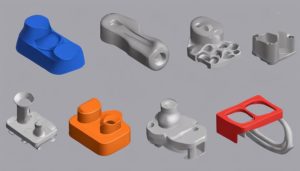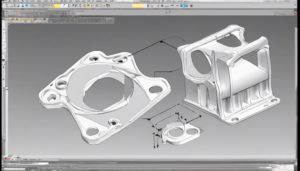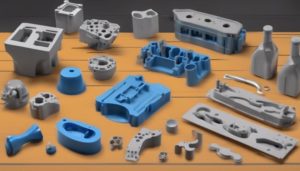Injection molding is a vital process where molten plastic is injected into a mold cavity under high pressure. This method is essential for creating detailed plastic parts efficiently. Mold design, cooling, and selecting the right resin are key aspects for successful production. Understanding the mechanism of injection molding, types of resins, and the importance of mold design are fundamental for beginners. Mastering these elements guarantees the production of high-quality plastic components. Explore further insights to enhance your understanding of the intricate injection molding process.
Basics of Injection Molding Process
The fundamental operation of the injection molding process revolves around the precise injection of molten plastic material into a designated mold cavity under controlled high pressure. This process is essential in manufacturing plastic parts with intricate designs and shapes. The molten plastic, often in the form of resin, is forced into the mold cavity, where it cools and solidifies to take the shape of the mold. Injection molding is a widely used manufacturing method due to its ability to produce large quantities of parts with high accuracy and consistency.
The design of the mold plays an important role in the injection molding process, ensuring that the molten plastic flows smoothly and solidifies correctly. Cooling channels integrated into the mold aid in rapidly cooling the molten material, speeding up the production cycle. Key components such as the injection unit, clamping unit, mold cavity, and ejection system work in tandem to facilitate the efficient production of plastic parts through injection molding.
Working Mechanism of Injection Molding

Utilizing a precision-driven process, injection molding functions by injecting hot thermoplastic material into a designated mold cavity to fabricate intricate plastic components. The mold cavity design is pivotal in determining the final part geometry and quality. Temperature control is meticulously managed during the injection molding process to guarantee proper material flow, solidification, and cooling, which are essential for producing accurate and consistent plastic parts. This method allows for the manufacturing of complex shapes with tight tolerances, making it a preferred choice for industries requiring high repeatability and precision.
Injection molding is widely used in mass production due to its ability to produce a large volume of plastic components efficiently. The mold design is tailored to meet specific part requirements, considering factors such as material properties, part complexity, and production volume. With its capability to achieve intricate part geometries and maintain tight tolerances, injection molding stands out as a versatile manufacturing technique for various industries seeking cost-effective and high-quality plastic parts.
Types of Injection Molding Resins

When selecting resins for injection molding applications, it is important to examine the specific properties of each material to guarantee excellent performance and quality of the final plastic components. Injection molding materials encompass a range of options including common choices like ABS, polycarbonate, and polypropylene. These resins are chosen based on their unique characteristics such as strength, flexibility, and heat resistance.
Additionally, specialty resins such as nylon, acrylic, and POM are utilized for specific applications that require distinct properties. Resin additives like glass fibers and talc play an important role in enhancing properties like stiffness and impact resistance, further improving the overall performance of the molded parts.
Understanding the resin characteristics is essential for achieving the desired part properties and performance levels in injection molding processes. By carefully considering the resin properties and selecting the appropriate material, manufacturers can ensure the production of high-quality plastic components with the required strength, flexibility, and heat resistance.
Importance of Mold Design in Molding

In injection molding, the efficiency and quality of the final plastic components are greatly influenced by the precision and effectiveness of the mold design. Mold design plays a vital role in determining part quality, production efficiency, and overall cost within the injection molding process.
A well-thought-out mold design considers factors such as part geometry, cooling system design, and material flow optimization. The design of the mold directly impacts cycle time, tooling longevity, and the consistency of the produced parts.
Key considerations in mold design include incorporating appropriate draft angles, ensuring proper venting for air escape, and implementing efficient gating systems for material flow control. Utilizing advanced mold design software enables engineers to simulate and optimize mold designs, leading to enhanced part production outcomes.
Therefore, investing time and resources in meticulous mold design is essential for achieving high-quality plastic components with efficient production efficiency.
Cooling Stage in Injection Molding

The cooling stage in injection molding is an essential phase that plays a fundamental role in the solidification of the molten plastic material within the mold cavity. Proper cooling is important to prevent issues such as warping and shrinkage, ensuring the production of high-quality parts.
The cooling time required during this stage is determined by factors like the material being used, the geometry of the part, and its wall thickness. To expedite the cooling process and reduce production cycles, efficient cooling systems, such as water channels integrated into the mold, are commonly employed.
Monitoring and controlling the cooling stage are crucial aspects of the injection molding process as they contribute significantly to achieving consistent part quality and dimensional accuracy. By carefully managing the cooling stage, manufacturers can enhance the overall efficiency and effectiveness of the injection molding process, resulting in precise and defect-free final products.
Injection Molding Machine Components

During the injection molding process, the components of the injection molding machine, namely the injection unit, clamping unit, and mold, work in tandem to produce precise and high-quality plastic parts.
4 Key Components:
- Injection Unit: This component is responsible for melting the plastic material and then injecting it into the mold cavity. The injection unit guarantees the accurate and consistent delivery of molten material into the mold.
- Clamping Unit: The clamping unit's primary function is to hold the mold in place securely during the injection and cooling process. It applies and maintains the necessary clamping force to keep the mold closed under pressure.
- Mold Cavity: The mold cavity is where the molten plastic material is injected and solidifies, taking the shape of the desired part. It is essential for forming the final product accurately.
- Efficient Production: Each of these components plays a significant role in the injection molding process, working together to ensure the efficient production of high-quality plastic parts. The seamless coordination between the injection unit, clamping unit, and mold is essential for achieving consistent and reliable results.
Achieving Quality in Injection Molding

Achieving peak quality standards in injection molding necessitates meticulous control of critical parameters such as temperature, pressure, and cooling duration. By adhering to specific standards and implementing scientific practices, manufacturers can enhance the quality of their molded products. Inspection techniques like First Article Inspection and Production Part Approval Process (PPAP) play an important role in verifying that quality standards are met throughout the production process. Compliance with industry standards, such as ISO 13485 for medical devices, is essential for ensuring high-quality production. Quality control systems are imperative for maintaining precision and consistency in the mass production of molded parts.
| Parameters | Importance | Control Systems |
|---|---|---|
| Temperature | Critical for melt | PID Controllers |
| Pressure | Ensures fill | Hydraulic Valves |
| Cooling Time | Affects part ejection | Timer Systems |
These parameters must be carefully monitored and adjusted to achieve excellent molding conditions and produce high-quality parts consistently.
Frequently Asked Questions
What Is the Injection Molding Process Step by Step?
The injection molding process unfolds in a series of steps:
- Melting plastic resin in a heated barrel.
- Injecting the molten material into a mold cavity under high pressure.
- Utilizing cooling channels in the mold for solidification.
- Opening the mold for part ejection.
This method involves precise stages like clamping, injection, cooling, and demolding to efficiently manufacture high-quality plastic parts.
What Are the 4 Stages of Injection Molding?
The 4 stages of injection molding are:
- Clamping, which guarantees mold closure to prevent material leakage.
- Injection, involving high-pressure injection of molten material into the mold cavity.
- Cooling, which solidifies the material for shaping.
- Ejection, the final stage where the mold opens, and the finished part is ejected.
Understanding these stages is essential for efficient and quality production in injection molding processes.
What Is the Basic Knowledge of Injection Molding?
Injection molding is a manufacturing process that involves injecting molten plastic material into a mold cavity to create plastic parts. Basic knowledge includes understanding mold design, material selection, process parameters, and quality control measures to guarantee consistent part quality.
It is essential to have precise control over factors like temperature, pressure, and cooling for successful injection molding. This process is widely used in various industries for mass production of plastic components.
How Do I Get Started With Injection Molding?
To get started with injection molding, first define your production needs and budget constraints. Research and select a reputable machine supplier. Design or obtain a mold tailored to your part requirements.
Understand the injection molding process steps like clamping, injection, cooling, and ejection. Familiarize yourself with common defects for quality improvement. Consider consulting with experienced professionals for guidance.
Following these steps will lay a solid foundation for your injection molding journey.
Conclusion
To sum up, injection molding is a complex process that requires careful attention to detail in order to achieve high-quality products.
It is like a well-oiled machine, with each component working together seamlessly to produce precise and consistent results.
By understanding the basics of injection molding, including the working mechanism, types of resins, mold design, cooling stage, and machine components, manufacturers can optimize their production processes and deliver superior products to the market.







